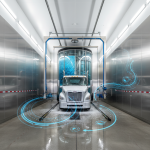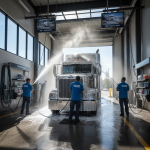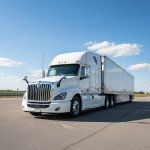In today’s fast-paced world, efficiency and quality are two crucial factors that businesses aim for when it comes to their operations. When it comes to maintaining and cleaning heavy-duty vehicles, a rollover gantry truck wash can offer the perfect solution. With a time-saving and reliable design, these advanced truck wash systems are becoming a go-to choice for businesses in need of efficient and effective truck washing.
A rollover gantry truck wash operates on a gantry system, where the vehicle remains stationary while powerful wash nozzles move along the length of the vehicle, thoroughly cleaning every nook and crevice. This automated process not only saves valuable time but also ensures a high level of cleanliness and quality.
With the ability to handle a wide range of vehicles, from large trucks to trailers, rollover gantry truck washes are a versatile option for businesses in various industries. Whether it’s a fleet of delivery trucks, construction vehicles, or agricultural machinery, these wash systems guarantee a thorough and consistent clean every time.
In conclusion, investing in a rollover gantry truck wash can provide businesses with the efficiency and quality they need for their vehicle cleaning requirements. Say goodbye to manual labor and hello to automated excellence.
A rollover gantry truck wash, also known as a rollover truck wash or gantry car wash, is a specialized equipment designed to clean and wash large vehicles, such as trucks, buses, and other oversized vehicles. It is typically used in industries like transportation, logistics, and public transportation to maintain the cleanliness and hygiene of these vehicles.
Here’s how a rollover gantry truck wash typically works:
- Vehicle Placement: The truck or other large vehicle is driven onto a set of rails or tracks that guide it through the wash bay.
- Automated System: The wash bay is equipped with a gantry system that moves back and forth over the length of the vehicle. This gantry system is equipped with various washing components, such as high-pressure water jets, brushes, and soap dispensers.
- Washing Process: As the gantry moves over the vehicle, it performs a sequence of cleaning actions. High-pressure water jets spray water and cleaning solutions onto the vehicle to remove dirt, grime, and other contaminants. Brushes or soft foam material may also make contact with the vehicle to scrub and remove stubborn debris.
- Rinsing: After the cleaning process, the gantry may go through a rinsing phase where clean water is sprayed to remove any remaining soap and dirt.
- Drying: Some gantry truck wash systems include drying components, such as large blowers or air curtains, to remove excess water from the vehicle’s surface.
- Exit: Once the vehicle has been thoroughly cleaned and rinsed, it is guided out of the wash bay, completing the washing process.
Rollover gantry truck washes are highly efficient and effective at cleaning large vehicles quickly and consistently. They are designed to save time and labor compared to manual cleaning methods, and they often incorporate recycling systems to reduce water usage and environmental impact. These facilities are essential for maintaining the appearance of commercial vehicles, preventing corrosion, and ensuring safety by keeping windows and mirrors clean and clear.
What are the wash steps of a rollover gantry truck wash
The wash steps of a rollover gantry truck wash typically involve a series of automated processes to thoroughly clean a large vehicle. Here are the common wash steps you can expect in such a facility:
- Pre-Wash Rinse: The vehicle enters the wash bay, and the first step is often a pre-wash rinse. High-pressure water jets spray the vehicle to remove loose dirt, mud, and debris.
- Pre-Soak Application: A pre-soak solution is applied to the vehicle’s surface. This solution is typically a mixture of detergents and chemicals designed to break down and loosen stubborn dirt, grease, and grime.
- Brushing or High-Pressure Washing: Depending on the specific system, the gantry may use either rotating brushes or high-pressure water jets to scrub the vehicle’s surface. Rotating brushes can be equipped with soft foam or other materials to ensure thorough cleaning without damaging the vehicle’s paint or finish.
- Detergent Application: Additional detergent or soap may be applied to the vehicle’s surface to enhance cleaning and remove tough stains.
- Brush or Cloth Contact: If brushes are used, they make contact with the vehicle’s surface to scrub and agitate the cleaning solution. If a cloth or fabric material is used, it gently wipes the vehicle.
- High-Pressure Rinse: After the cleaning and brushing stages, high-pressure water jets rinse the vehicle to remove the loosened dirt, soap, and detergent residue.
- Spot-Free Rinse: Some gantry truck wash systems include a spot-free rinse, which uses deionized or purified water to rinse the vehicle. This helps prevent water spots and streaks from forming as the vehicle dries.
- Drying: Large blowers or air curtains are often used to dry the vehicle’s surface thoroughly. These powerful air systems remove excess water, ensuring the vehicle leaves the wash bay with a clean and dry finish.
- Final Inspection: Some facilities may include a step where the vehicle undergoes a final inspection to ensure all areas are clean and dry. Any remaining spots or streaks may be manually addressed.
- Exit: Once the vehicle has completed all the wash steps and is confirmed to be clean and dry, it exits the wash bay.
These steps may vary slightly depending on the specific design and features of the gantry truck wash system, but they provide a general overview of the typical process. Automated gantry truck washes are designed to efficiently and effectively clean large vehicles while minimizing the need for manual labor.
Are rollover gantry truck washes suitable for tractor trailer fleets and commercial truck washes
Yes, rollover gantry truck washes are indeed suitable for tractor-trailer fleets and commercial truck washes. In fact, they are widely used in such applications due to their efficiency, speed, and effectiveness in cleaning large vehicles. Here’s why they are well-suited for tractor-trailer fleets and commercial truck washes:
- Efficiency: Rollover gantry truck washes are highly efficient, and they can clean large vehicles quickly. This is essential for commercial truck washes where time is money, and tractor-trailer fleets need to get back on the road promptly.
- Consistency: Automated systems ensure consistent cleaning quality. Every vehicle that goes through the wash receives the same level of cleaning, reducing the risk of missed spots or inadequate cleaning.
- Labor Savings: These systems require minimal manual labor compared to handwashing or other methods. This is advantageous for commercial operations that aim to minimize labor costs.
- Thorough Cleaning: Rollover gantry truck washes are designed to provide thorough cleaning, which is crucial for tractor-trailers and commercial trucks that accumulate significant dirt, grime, and road debris during their travels.
- Large Vehicle Compatibility: These washes are specifically designed to accommodate the size and shape of tractor-trailers and other large commercial vehicles, ensuring they can be cleaned effectively.
- Environmental Considerations: Many gantry truck wash systems incorporate water recycling and treatment systems, helping to reduce water consumption and minimize environmental impact.
- Maintenance and Corrosion Prevention: Regular cleaning in a gantry truck wash helps maintain the appearance of commercial vehicles and prevents the buildup of corrosive materials, extending the lifespan of the trucks.
- Safety and Visibility: Clean vehicles are safer vehicles. Removing dirt and grime from windows, mirrors, and headlights improves visibility and safety on the road.
Overall, rollover gantry truck washes are a cost-effective and practical solution for maintaining the cleanliness and hygiene of tractor-trailer fleets and commercial trucks. They are designed to meet the unique needs of these large vehicles and are a valuable asset for businesses in the transportation and logistics industry.
Do automatic rollover gantry truck washes clean tractor trailers as good as pressure washing
Automatic rollover gantry truck washes can clean tractor trailers effectively and efficiently, but whether they clean as well as pressure washing depends on several factors, including the specific design of the wash system, the cleaning equipment used, and the level of maintenance required for the tractor trailers. Here are some considerations:
- Cleaning Mechanisms: Rollover gantry truck washes typically use a combination of rotating brushes or high-pressure water jets, along with detergents and cleaning solutions, to clean vehicles. These mechanisms can effectively remove dirt, grime, and surface contaminants.
- Efficiency: Automatic gantry truck washes are designed for efficiency and speed, allowing them to clean vehicles quickly, which is essential for commercial operations. Pressure washing, on the other hand, may be slower and may require more manual labor.
- Consistency: Automatic wash systems provide consistent cleaning quality, ensuring that every part of the tractor trailer receives the same level of cleaning. Pressure washing may require more attention to detail and manual effort to achieve uniform results.
- Accessibility: Gantry truck washes are designed to accommodate large vehicles like tractor trailers, ensuring that all areas, including the top and sides, can be cleaned effectively. Pressure washing may require more effort to reach all areas, especially the upper portions of the trailer.
- Environmental Considerations: Some gantry truck wash systems incorporate water recycling and treatment systems, which can be more environmentally friendly by reducing water consumption and managing wastewater responsibly.
Pressure washing may have some advantages, but also some disadvantages:
- Adjustability: Pressure washing equipment allows operators to adjust the water pressure and nozzle settings to address specific cleaning challenges. This flexibility can be advantageous when dealing with particularly stubborn stains or heavily soiled areas.
- Direct Contact: Pressure washing uses the direct force of high-pressure water, which can be effective for dislodging tough, ingrained contaminants.
- Versatility: Pressure washing equipment can be used for various cleaning tasks beyond just tractor trailers, making it a versatile choice for businesses that require cleaning services for a variety of surfaces and equipment.
- Labor intensive: Pressure washing a tractor and trailer requires 3-5 people to do the job in approximately 45 mins.
- Time Consuming: A tractor trailer hand pressure wash requires at least 45 mins to complete. Not all drivers or fleet operators will invest this much time in washing.
- High Water Volume usage: Pressure washing wastes a lot of water and therefore uses considerably more water to wash due to the volume and duration of a typical pressuer wash on a large vehicle.
In summary, automatic rollover gantry truck washes are designed for speed and efficiency and can effectively clean tractor trailers. However, pressure washing offers more adjustability and direct force, which can be advantageous in certain situations. The choice between the two methods depends on the specific cleaning needs, budget considerations, and operational preferences of the fleet or business. Some operations may even use a combination of both methods to ensure thorough cleaning.




